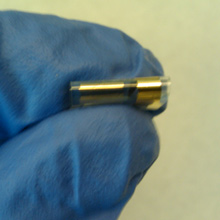An Implantable Antenna
August 18, 2010 | Source: Technology Review
Researchers at Tufts University have designed a small antenna from liquid silk and micropatterned gold, designed to spot specific proteins and chemicals in the body, and alert doctors wirelessly to signs of disease.
According to Fiorenzo Omenetto, professor of biomedical engineering at Tufts University, implanted in the body, silk can conform to any tissue surface, and, unlike conventional polymer-based implants, it could stay in place over a long period of time without adverse effects.
Scientists say the implant could someday help patients with diabetes track their glucose levels without having to test themselves daily.
Omenetto and his colleague Richard Averitt, associate professor of physics at Boston University, used similar principles to create a metamaterial that’s responsive not to visible light, but rather to frequencies further down the electromagnetic spectrum, within the terahertz range. Proteins, enzymes, and chemicals in the body are naturally resonant at terahertz frequencies, and, according to Averitt, each biological agent has its own terahertz “signature.”
